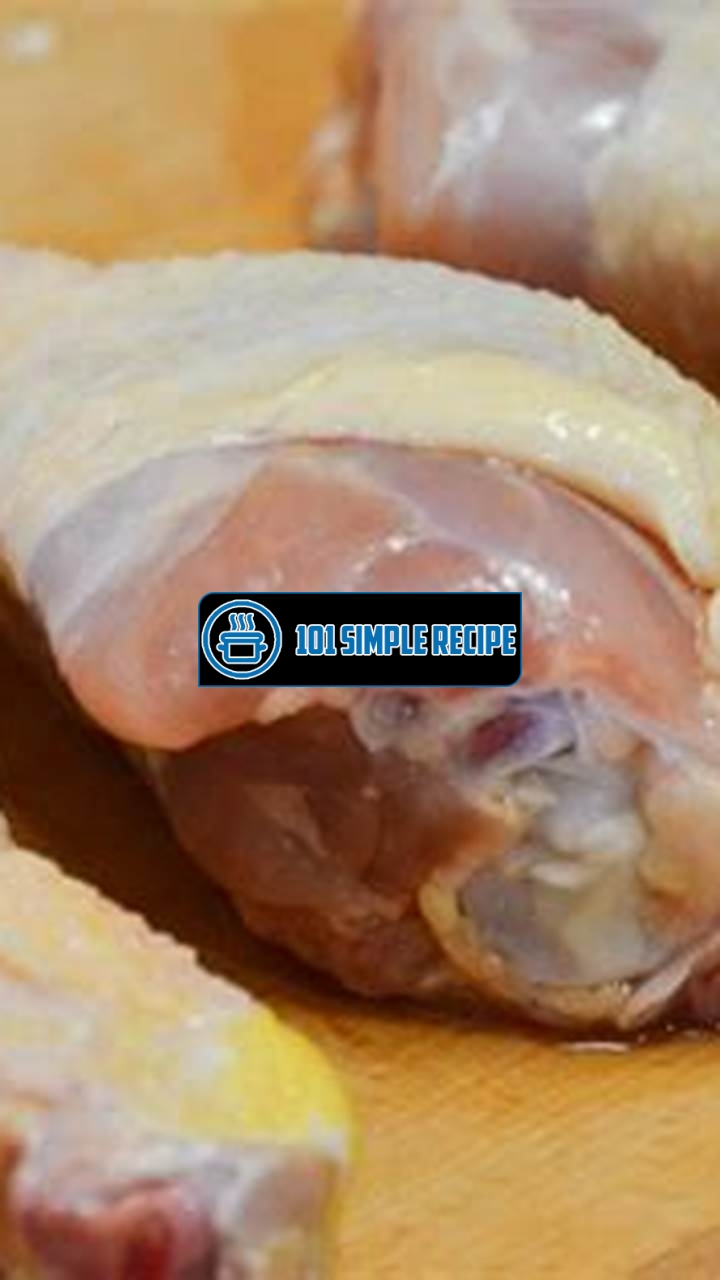Are you unsure if the raw chicken sitting in your fridge is still safe to eat? It’s essential to know how to tell if raw chicken has gone bad to prevent any potential foodborne illnesses. In this article, we will guide you through the signs and indicators that can help you determine if your chicken has spoiled. By recognizing these key factors, you can ensure that you and your loved ones consume only safe and healthy poultry. So let’s dive in and learn how to assess the freshness of raw chicken!

Understanding Chicken Safety
Educate yourself about the crucial aspects of chicken safety to ensure you can identify if raw chicken is bad.
Importance of Proper Handling
Proper handling of raw chicken is essential to prevent foodborne illnesses. When you purchase raw chicken, it’s crucial to keep it at a safe temperature to avoid bacteria growth. ️ To ensure chicken safety, always follow these handling guidelines:
- When shopping, pick up the chicken last to minimize the time it spends outside refrigeration.
- Ensure the chicken is properly sealed and there are no leaks in the packaging.
- Use a separate bag to contain the chicken and prevent cross-contamination with other foods.
- Transport the chicken home promptly, avoiding prolonged exposure to warmer temperatures.
Once you’re home, it’s important to further prioritize proper handling:
- Wash your hands thoroughly with soap and warm water before and after handling raw chicken.
- Use dedicated cutting boards and utensils for raw chicken to prevent cross-contamination.
- Clean and sanitize any surfaces that come into contact with raw chicken.
- Avoid washing raw chicken, as it can spread bacteria through splashing water.
Storage Guidelines for Raw Chicken
To maintain chicken safety, it’s crucial to store raw chicken correctly. Keep the following storage guidelines in mind:
- Refrigerate raw chicken immediately after purchase or use. The ideal temperature for chicken storage is 40°F (4°C) or below. ❄️
- If you aren’t planning to use the chicken within two days, consider freezing it for longer shelf life. Wrap it tightly in freezer-safe packaging to prevent freezer burn.
- Always place raw chicken on the lowest shelf of the refrigerator to prevent juices from dripping onto other foods.
- Ensure that the refrigerator and freezer are set to the appropriate temperatures to maintain food safety.
Recognizing Signs of Spoiled Chicken
Knowing how to identify signs of spoiled chicken is crucial in ensuring your safety. Here are some red flags to watch out for:
- Unpleasant odor: If the raw chicken smells sour, rotten, or has an off-putting odor, it is likely spoiled. ❌
- Change in color and texture: Fresh raw chicken should have a pinkish color and firm texture. If it appears grayish or slimy, discard it immediately.
- Presence of mold: If you notice mold growth on the chicken, do not consume it. Dispose of it carefully.
- Unusual liquid: If there is an excessive amount of liquid in the packaging or it appears murky, it’s a sign that the chicken has gone bad.
- Expiration date: Check the expiry date on the packaging. If the chicken has exceeded the date, it is likely unsafe to consume.
Remember, consuming spoiled chicken can lead to food poisoning and gastrointestinal issues. When in doubt, it’s always better to err on the side of caution and discard the chicken.
By understanding chicken safety, proper handling, storage guidelines, and recognizing signs of spoiled chicken, you can ensure that the raw chicken you consume is fresh and safe to eat. Stay vigilant and prioritize food safety to protect yourself and your loved ones!
Freshness Indicators
When it comes to cooking raw chicken, freshness is of utmost importance to ensure food safety. There are several visual and sensory cues you can rely on to determine whether raw chicken has gone bad. By familiarizing yourself with these freshness indicators, you can make informed decisions and avoid consuming spoiled chicken that may lead to foodborne illnesses.
Checking the Sell-By Date
One of the easiest ways to assess the freshness of raw chicken is by checking the sell-by date. This date is typically printed on the packaging and indicates the last day the chicken should be sold by the retailer. While it is not an absolute indicator of whether the chicken has gone bad, it gives you a good starting point. If the sell-by date has not yet passed, it is likely that the chicken is still fresh. However, it is important to note that if the sell-by date has already passed, the chicken may still be safe to consume if it has been stored properly.
① It’s crucial to remember that the sell-by date is not an expiration date, but rather a guideline for retailers. ② Always rely on your senses and other indicators to make the final judgment on the chicken’s freshness.
Examining the Color and Texture
The color and texture of raw chicken can also provide valuable information about its freshness. Fresh chicken should have a pinkish color. If you notice any gray or greenish discoloration, it could be a sign that the chicken is no longer fresh. Similarly, if the texture feels slimy or tacky to the touch, it is a strong indication that the chicken has spoiled.
① Remember that fresh chicken should retain its pinkish color. Any unusual discoloration may indicate spoilage.
② Additionally, always be cautious if the texture feels slimy or tacky as it is a clear sign of spoilage.
Sniff Test: Detecting Off Odors
Your sense of smell is a powerful tool when it comes to determining the freshness of raw chicken. Give the chicken a sniff to detect any off odors. Fresh chicken should have a neutral or slightly sweet smell. If you notice any sour, ammonia-like, or pungent odors, it is a strong indication that the chicken has gone bad. Trust your instincts and err on the side of caution if you detect any unpleasant smells.
① Always rely on your sense of smell to identify any off odors coming from raw chicken.
② If the chicken emits sour, ammonia-like, or pungent smells, it is a sure sign of spoilage.
By paying attention to these freshness indicators – checking the sell-by date, examining the color and texture, and conducting the sniff test – you can confidently determine whether raw chicken has gone bad. Remember, when in doubt, it is better to discard the chicken to avoid any potential health risks. Stay vigilant about food safety and enjoy cooking with fresh and wholesome ingredients!
If you’re wondering how to tell if raw chicken is bad, it’s important to know the signs of spoilage. One important resource is this peanut butter cup recipe that can give you an idea of what fresh chicken should look and smell like. Another helpful guide is this hoisin sauce recipe which can help you understand how to properly handle and store raw chicken to avoid contamination. And if you’re concerned about the safety of your chicken, this malibu sunset recipe can provide insights on how to cook chicken to the recommended internal temperature.
Bacterial Contamination
Understanding the risks associated with bacterial contamination in raw chicken is crucial for protecting your health. Bacterial contamination can occur at any stage of the poultry production process, from farm to table. Consuming raw or undercooked chicken that is contaminated with harmful bacteria can lead to food poisoning, which can range from mild discomfort to severe illness. It is important to be aware of the common bacterial strains found in chicken, the symptoms of food poisoning, and how to prevent bacterial contamination.
Common Bacterial Strains in Chicken
There are several bacterial strains that are commonly found in raw chicken. The most prevalent strains include:
- Salmonella: This bacterium is one of the leading causes of food poisoning globally. It can cause symptoms such as diarrhea, vomiting, abdominal pain, and fever.
- Campylobacter: Another common bacterium found in chicken, Campylobacter can cause symptoms similar to salmonella, including diarrhea, stomach cramps, and fever.
- Escherichia coli (E. coli): While most strains of E. coli are harmless, certain strains, such as E. coli O157:H7, can cause severe illness. Symptoms include bloody diarrhea, stomach cramps, and sometimes kidney failure.
It is important to note that these bacteria can be present on raw chicken even if it appears fresh and doesn’t have any noticeable odor or discoloration. Therefore, proper cooking and handling techniques are essential to prevent foodborne illnesses.
Identifying Symptoms of Food Poisoning
Recognizing the symptoms of food poisoning is crucial for seeking timely medical attention and preventing further complications. The symptoms may vary depending on the bacterial strain and individual susceptibility. Common symptoms of food poisoning from bacterial contamination in raw chicken include:
- Diarrhea: This is one of the most common symptoms of food poisoning. It may be watery or bloody in some cases.
- Nausea and vomiting: These symptoms often accompany diarrhea and can contribute to dehydration.
- Abdominal cramps: Severe stomach pain and cramps may occur due to infection.
- Fever: A higher body temperature is a common response to bacterial infections.
- Weakness and fatigue: Bacterial contamination can leave you feeling exhausted and weak.
If you experience any of these symptoms after consuming raw chicken or dishes containing it, it is important to seek medical attention promptly, especially if the symptoms persist or worsen.
Preventing Bacterial Contamination
Preventing bacterial contamination in raw chicken begins with safe handling and proper cooking practices. Here are some essential tips to prevent bacterial contamination:
- Proper refrigeration: Store raw chicken at or below 40°F (4°C) to slow down bacterial growth. Make sure to keep it separate from other foods to avoid cross-contamination.
- Cooking to the correct temperature: Ensure that raw chicken reaches an internal temperature of at least 165°F (74°C) to kill harmful bacteria. Use a food thermometer to accurately measure the temperature.
- Avoid cross-contamination: Use separate cutting boards, utensils, and plates for raw chicken to prevent the spread of bacteria to other foods.
- Proper hand hygiene: Wash your hands thoroughly with soap and water before and after handling raw chicken. This helps prevent the transfer of bacteria from the chicken to other surfaces.
- Avoid consuming raw chicken: Cook chicken thoroughly before consumption to kill any potential bacteria. Eating raw or undercooked chicken increases the risk of food poisoning.
Note: It is essential to follow these food safety practices not only with chicken but also with any other type of raw meat to prevent bacterial contamination and foodborne illnesses.
By understanding the risks associated with bacterial contamination in raw chicken, familiarizing yourself with the common bacterial strains, recognizing the symptoms of food poisoning, and adopting proper prevention measures, you can protect yourself and your loved ones from the dangers of consuming spoiled or contaminated chicken.
Proper Food Storage
When it comes to storing raw chicken, following proper food storage practices is crucial to ensure its safety and freshness. By understanding the best practices for storage, you can prevent bacteria growth and maintain the quality of your chicken. Let’s dive into the key aspects of proper food storage for raw chicken:
Temperature Control in the Refrigerator
Temperature control plays a vital role in keeping raw chicken safe to consume. The ideal temperature for your refrigerator should be set at or below 40°F (4°C). This low temperature helps slow down bacterial growth, reducing the risk of spoilage. It is important to regularly check and adjust the temperature settings of your refrigerator to maintain the optimal conditions.
️Important: Keep your refrigerator temperature at or below 40°F (4°C) to prevent bacterial growth and maintain raw chicken’s freshness.
Using Airtight Packaging
Proper packaging is essential to protect raw chicken from contamination and extend its shelf life. The best option is to use airtight packaging, such as sealed plastic bags or airtight containers. This helps prevent the chicken from coming into contact with air, which can accelerate spoilage. Airtight packaging also prevents cross-contamination, reducing the risk of bacteria spreading to other foods in your refrigerator.
Important: Store raw chicken in airtight packaging, such as sealed plastic bags or airtight containers, to maintain its freshness and prevent cross-contamination.
Separation from Other Foods
When storing raw chicken, it is crucial to separate it from other foods in your refrigerator. Raw chicken can contain harmful bacteria like Salmonella and Campylobacter, which can easily transfer to other foods through contact or drippings. To avoid cross-contamination, keep raw chicken in a separate section or on a lower shelf of your refrigerator. Additionally, make sure to clean any surfaces or utensils that come into contact with raw chicken to prevent the spread of bacteria.
Important: Always separate raw chicken from other foods in your refrigerator to prevent cross-contamination and the spread of harmful bacteria.
Proper food storage is key
By following these practices for proper food storage, you can ensure that your raw chicken remains safe and fresh. Remember to maintain the right temperature in your refrigerator, use airtight packaging, and separate raw chicken from other foods. These steps will help minimize the risk of bacterial growth and preserve the quality of your chicken until it’s ready to be cooked.
ℹ️Note: It’s important to always adhere to food safety guidelines and use your judgment when determining if raw chicken has gone bad. If you notice any unusual odor, sliminess, or discoloration in the chicken, it’s best to discard it to avoid any potential health risks.
Cooking Techniques for Safety
When it comes to cooking chicken, it is important to follow proper techniques to ensure safety and eliminate harmful bacteria. By implementing the right cooking methods, you can guarantee that your chicken is safe to consume. Here are some tips to help you cook chicken safely:
Recommended Internal Temperature
One of the essential factors for ensuring chicken safety is cooking it to the right internal temperature. The United States Department of Agriculture (USDA) recommends cooking chicken to a minimum internal temperature of 165°F (74°C). This temperature ensures that any harmful bacteria, such as salmonella, is killed.
Remember to insert the thermometer into the thickest part of the chicken without touching the bone. Make sure to check the temperature in multiple spots to ensure consistency. If the chicken hasn’t reached the recommended temperature, continue cooking until it does. This simple step can greatly reduce the risk of foodborne illnesses.
Using a Food Thermometer
Using a food thermometer is an effective way to determine if your chicken has reached the appropriate internal temperature. There are different types of food thermometers available, but it is recommended to use a digital thermometer for its accuracy and easy-to-read display.
To use a food thermometer, insert it into the thickest part of the chicken without touching the bone. Wait for the thermometer reading to stabilize, and make sure it reaches 165°F (74°C) or higher. By relying on a food thermometer, you can be confident that your chicken is cooked thoroughly and safe to eat.
Safe Handling of Cooked Chicken
Even after cooking your chicken to the recommended internal temperature, it is crucial to handle it safely to prevent contamination. Here are some tips for the safe handling of cooked chicken:
- Storage: After cooking, promptly refrigerate any leftover chicken within two hours. Place it in a shallow container and cover it tightly to prevent the growth of bacteria. Consuming leftovers within three or four days is advised.
- Separation: Keep cooked chicken separate from raw chicken to prevent cross-contamination. Use different cutting boards, utensils, and plates for raw and cooked chicken.
- Reheating: When reheating cooked chicken, make sure it reaches a minimum internal temperature of 165°F (74°C). Use a food thermometer to verify the temperature and heat it thoroughly.
Note: Following these safe handling practices will reduce the risk of foodborne illnesses and help you enjoy your chicken without any worries.
By implementing these cooking techniques and following the recommended internal temperature for cooking chicken, you can ensure the safety of your meals. Safe handling practices also play a crucial role in preventing foodborne illnesses. Remember to always use a food thermometer and handle cooked chicken with care. Enjoy your delicious, safe-to-eat chicken dishes!
Frequently Asked Questions
If you have any more questions about how to determine if raw chicken is bad, we’ve got you covered!
| No. | Questions | Answers |
|---|---|---|
| 1. | How can you tell if raw chicken is spoiled? | To check if raw chicken is bad, look for signs such as an unpleasant odor, slimy texture, or discoloration. Additionally, if the chicken has been stored improperly or for too long, it may also indicate spoilage. Trust your senses and when in doubt, it’s best to throw it out. |
| 2. | What should fresh raw chicken smell like? | Fresh raw chicken should have a mild, almost sweet smell. If the odor is strong, off-putting, or sour, it may be an indication of spoilage. |
| 3. | Can you eat raw chicken that smells bad after cooking it? | No, you should not eat chicken that smells bad after cooking. Cooking may kill some bacteria, but it cannot neutralize the toxins produced by certain harmful bacteria. It’s always important to discard any chicken with an off-putting odor. |
| 4. | Is it safe to eat chicken with a slimy texture? | No, a slimy texture on raw chicken is not a good sign. It could indicate the growth of bacteria or other microorganisms. It’s best to err on the side of caution and dispose of any slimy chicken. |
| 5. | What color should raw chicken be? | Fresh raw chicken should have a pinkish color. If the chicken appears gray or yellow, it may indicate spoilage or improper handling. Always prioritize safety and opt for fresh-looking chicken. |
| 6. | Can you freeze raw chicken if it’s nearing its expiration date? | Yes, you can freeze raw chicken that is nearing its expiration date. Freezing can help extend its shelf life. However, make sure to wrap it properly and label it with the date to ensure you use it within a safe timeframe. |
Thanks for Reading! Visit Again Later!
We hope this article was helpful in teaching you how to determine if raw chicken is bad. Your safety in the kitchen is crucial, and being able to recognize signs of spoilage can prevent foodborne illnesses. Remember to trust your senses, and when in doubt, it’s better to be safe than sorry. Don’t forget to visit our website for more informative articles on food safety and cooking tips. Stay healthy and happy cooking!
Jump to Recipe
How Do You Know if Raw Chicken is Bad

Learn how to determine if raw chicken is bad by recognizing signs of spoilage. Know when to safely consume or discard raw chicken to prevent foodborne illnesses.
- 2 pounds of raw chicken
- Salt and pepper to taste
- Inspect the chicken for an unpleasant odor, slimy texture, or discoloration.
- Check if the chicken smells fresh and mild.
- Cook the chicken thoroughly to kill any harmful bacteria.
- Discard any chicken that smells bad after cooking.
- Do not consume chicken with a slimy texture.
- Ensure raw chicken has a pinkish color, not gray or yellow.
- If nearing expiration, freeze raw chicken for extended shelf life.






